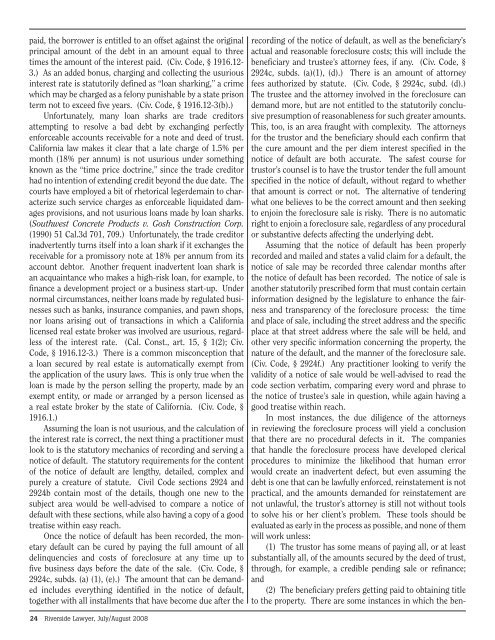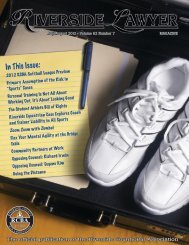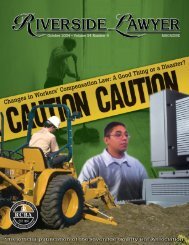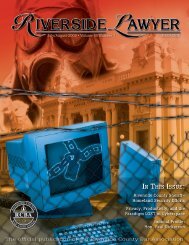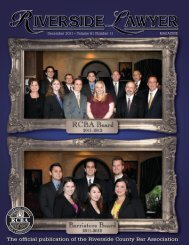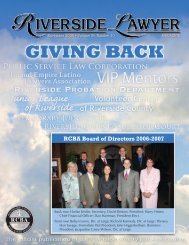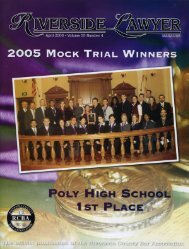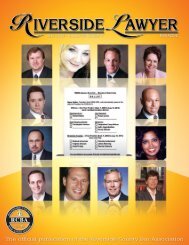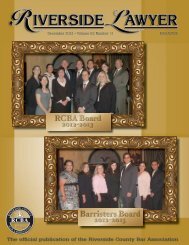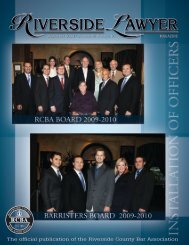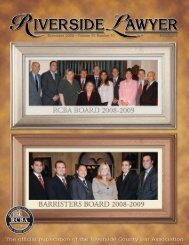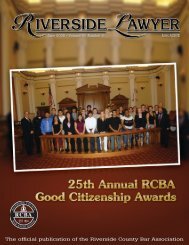IN THIS ISSUE: - Riverside County Bar Association
IN THIS ISSUE: - Riverside County Bar Association
IN THIS ISSUE: - Riverside County Bar Association
Create successful ePaper yourself
Turn your PDF publications into a flip-book with our unique Google optimized e-Paper software.
paid, the borrower is entitled to an offset against the original<br />
principal amount of the debt in an amount equal to three<br />
times the amount of the interest paid. (Civ. Code, § 1916.12-<br />
3.) As an added bonus, charging and collecting the usurious<br />
interest rate is statutorily defined as “loan sharking,” a crime<br />
which may be charged as a felony punishable by a state prison<br />
term not to exceed five years. (Civ. Code, § 1916.12-3(b).)<br />
Unfortunately, many loan sharks are trade creditors<br />
attempting to resolve a bad debt by exchanging perfectly<br />
enforceable accounts receivable for a note and deed of trust.<br />
California law makes it clear that a late charge of 1.5% per<br />
month (18% per annum) is not usurious under something<br />
known as the “time price doctrine,” since the trade creditor<br />
had no intention of extending credit beyond the due date. The<br />
courts have employed a bit of rhetorical legerdemain to characterize<br />
such service charges as enforceable liquidated damages<br />
provisions, and not usurious loans made by loan sharks.<br />
(Southwest Concrete Products v. Gosh Construction Corp.<br />
(1990) 51 Cal.3d 701, 709.) Unfortunately, the trade creditor<br />
inadvertently turns itself into a loan shark if it exchanges the<br />
receivable for a promissory note at 18% per annum from its<br />
account debtor. Another frequent inadvertent loan shark is<br />
an acquaintance who makes a high-risk loan, for example, to<br />
finance a development project or a business start-up. Under<br />
normal circumstances, neither loans made by regulated businesses<br />
such as banks, insurance companies, and pawn shops,<br />
nor loans arising out of transactions in which a California<br />
licensed real estate broker was involved are usurious, regardless<br />
of the interest rate. (Cal. Const., art. 15, § 1(2); Civ.<br />
Code, § 1916.12-3.) There is a common misconception that<br />
a loan secured by real estate is automatically exempt from<br />
the application of the usury laws. This is only true when the<br />
loan is made by the person selling the property, made by an<br />
exempt entity, or made or arranged by a person licensed as<br />
a real estate broker by the state of California. (Civ. Code, §<br />
1916.1.)<br />
Assuming the loan is not usurious, and the calculation of<br />
the interest rate is correct, the next thing a practitioner must<br />
look to is the statutory mechanics of recording and serving a<br />
notice of default. The statutory requirements for the content<br />
of the notice of default are lengthy, detailed, complex and<br />
purely a creature of statute. Civil Code sections 2924 and<br />
2924b contain most of the details, though one new to the<br />
subject area would be well-advised to compare a notice of<br />
default with these sections, while also having a copy of a good<br />
treatise within easy reach.<br />
Once the notice of default has been recorded, the monetary<br />
default can be cured by paying the full amount of all<br />
delinquencies and costs of foreclosure at any time up to<br />
five business days before the date of the sale. (Civ. Code, §<br />
2924c, subds. (a) (1), (e).) The amount that can be demanded<br />
includes everything identified in the notice of default,<br />
together with all installments that have become due after the<br />
recording of the notice of default, as well as the beneficiary’s<br />
actual and reasonable foreclosure costs; this will include the<br />
beneficiary and trustee’s attorney fees, if any. (Civ. Code, §<br />
2924c, subds. (a)(1), (d).) There is an amount of attorney<br />
fees authorized by statute. (Civ. Code, § 2924c, subd. (d).)<br />
The trustee and the attorney involved in the foreclosure can<br />
demand more, but are not entitled to the statutorily conclusive<br />
presumption of reasonableness for such greater amounts.<br />
This, too, is an area fraught with complexity. The attorneys<br />
for the trustor and the beneficiary should each confirm that<br />
the cure amount and the per diem interest specified in the<br />
notice of default are both accurate. The safest course for<br />
trustor’s counsel is to have the trustor tender the full amount<br />
specified in the notice of default, without regard to whether<br />
that amount is correct or not. The alternative of tendering<br />
what one believes to be the correct amount and then seeking<br />
to enjoin the foreclosure sale is risky. There is no automatic<br />
right to enjoin a foreclosure sale, regardless of any procedural<br />
or substantive defects affecting the underlying debt.<br />
Assuming that the notice of default has been properly<br />
recorded and mailed and states a valid claim for a default, the<br />
notice of sale may be recorded three calendar months after<br />
the notice of default has been recorded. The notice of sale is<br />
another statutorily prescribed form that must contain certain<br />
information designed by the legislature to enhance the fairness<br />
and transparency of the foreclosure process: the time<br />
and place of sale, including the street address and the specific<br />
place at that street address where the sale will be held, and<br />
other very specific information concerning the property, the<br />
nature of the default, and the manner of the foreclosure sale.<br />
(Civ. Code, § 2924f.) Any practitioner looking to verify the<br />
validity of a notice of sale would be well-advised to read the<br />
code section verbatim, comparing every word and phrase to<br />
the notice of trustee’s sale in question, while again having a<br />
good treatise within reach.<br />
In most instances, the due diligence of the attorneys<br />
in reviewing the foreclosure process will yield a conclusion<br />
that there are no procedural defects in it. The companies<br />
that handle the foreclosure process have developed clerical<br />
procedures to minimize the likelihood that human error<br />
would create an inadvertent defect, but even assuming the<br />
debt is one that can be lawfully enforced, reinstatement is not<br />
practical, and the amounts demanded for reinstatement are<br />
not unlawful, the trustor’s attorney is still not without tools<br />
to solve his or her client’s problem. These tools should be<br />
evaluated as early in the process as possible, and none of them<br />
will work unless:<br />
(1) The trustor has some means of paying all, or at least<br />
substantially all, of the amounts secured by the deed of trust,<br />
through, for example, a credible pending sale or refinance;<br />
and<br />
(2) The beneficiary prefers getting paid to obtaining title<br />
to the property. There are some instances in which the ben-<br />
24 <strong>Riverside</strong> Lawyer, July/August 2008


